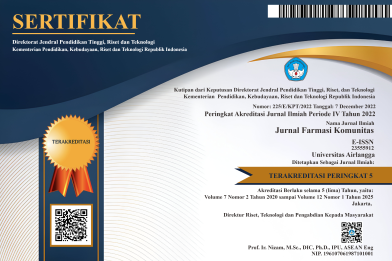Pemilihan Produk Anti Acne di Media Sosial pada Remaja di Beberapa Kota/Kabupaten di Indonesia
Downloads
Acne vulgaris adalah penyakit kulit kronis multifaktorial yang ditandai adanya peradangan dan banyak terjadi pada remaja. Munculnya konten-konten di media sosial mengenai produk antiacne dapat menimbulkan kesalahan dalam pemilihan produk antiacne. Penelitian ini bertujuan untuk mengetahui pemilihan produk antiacne di media sosial pada remaja di beberapa kota/kabupaten di Indonesia. Penelitian ini merupakan penelitian cross-sectional dengan instrumen berupa kuesioner yang disebar secara online melalui google form. Teknik pengambilan sampel dilakukan secara accidental sampling. Survei diikuti oleh 259 responden dengan rentang usia 12-20 tahun. Hasil penelitian menunjukkan sebesar 91,9% responden pernah menjumpai konten antiacne di media sosial, 33,6% responden cukup terpengaruh konten media sosial dalam pemilihan produk antiacne, 43,6% responden ingin membeli produk antiacne setelah melihat konten media sosial, dan 60,6% responden beralasan membeli produk antiacne setelah melihat review produk yang bagus. Sebagian besar remaja pernah menjumpai konten produk antiacne dan memiliki keinginan membeli produk setelah melihat konten produk antiacne di media sosial. Promosi kesehatan serta edukasi mengenai anti acne perlu dilakukan agar masyarakat khususnya remaja dapat memilih dan menggunakan anti acne dengan tepat.
Afriyanti, R. N. (2015) ‘Akne vulgaris pada remaja.', Jurnal Majority, 4(6), pp. 10-17.
Agustiara, R., Okatini, M., & Jumhur, A. A. (2019) ‘Effect of beauty vlogger testimonial (review) on consumer interest (viewers) on cosmetic products.', Jurnal of Business Studies, 5(2), pp. 149-156. doi: 10.32497/jobs.v5i2.1715.
Andrea, L. Z., Emmy, M. G., & Diane, M. T. (2012) Acne Vulgaris and Acne Iformeruptions in Dermatologi in General Medicine. 8th ed. New York: Mc Graw-HillCompanies.
Aqsha, A. C., Shafinaz, Dea, A., Nadya, A., Stefany, V. A., Ikhfan, T. J., Halima, S., Novi, A., Deva, G., & Rif'atul, I. E. (2016) ‘Profil pemilihan dan penggunaan produk antijerawat yang tepat pada mahasiswa.', Jurnal Farmasi Komunitas, 3(1), pp. 75-79.
Barbara, G. W., Joseph, T. D., Terry, L. S., & DiPiro, C. V. (2017) Pharmacotherapy Handbook. 10th ed. New York: McGraw-Hill Education.
Bharucha, J. (2018) ‘Social media and young consumers behavior.', International Journal of Supply Chain Management, 7(6), pp. 72-81.
Evelina, L. W., & Handayani, F. (2018) ‘Penggunaan digital influencer dalam promosi produk (studi kasus akun instagram @bylizzieparra.', Warta Ikatan Sarjana Komunikasi Indonesia, 1(1), pp. 71-82. doi: 10.25008/wartaiski.v1i01.10.
Fox, L., Csongrandi, C., Aucamp, M., Plessis, J., & Gerber, M. (2016) ‘Treatment modalities for acne.', Molecules, 21(8), pp. 1-20. doi: 10.3390/molecules21081063.
Hootsuite. (2020) Hootsuite (We Are Social): Indonesian Digital Report 2020. https://andi.link/hootsuite-we-are-social-indonesian-digital-report-2020/:s.n.
Kamila, K. T., Suharyono, & Nuralam, I. P. (2019) ‘Pengaruh online consumer review terhadap keputusan pembelian (survei pada mahasiswa Universitas Brawijaya TA 2015/2016 – 2018/2019 yang pernah membeli dan menggunakan Xiaomi Smartphone).', Jurnal Administrasi Bisnis, 72(1), pp. 202-211.
Kardon, B. (2007) ‘They're saying nasty things.', Marketing News, 41(20), pp. 30.
Mariana, M., Sartini, S., & Karim, A. (2018) ‘Efektivitas beberapa produk pembersih wajah antiacne terhadap bakteri penyebab jerawat' propionibacterium acnes.', Biolink Jurnal Biologi Lingkungan, Industri, Kesehatan, 5(1), pp. 31-41. doi: 10.31289/biolink.v5i1.1668.
Melinda, N. (2018) ‘Social media on campus: Studi peran media sosial sebagai media penyebaran informasi akademik pada mahasiswa di Program Studi Ilmu Komunikasi FISIP UNRI.', The Journal of Society & Media, 2(1), pp. 53-64. doi: 10.26740/jsm.v2n1.p53-64.
Nathan, A. (2010) Non Prescription Medicine. 4th ed. London: Pharmaceutical Press.
PERDOSKI. (2017) Panduan Praktik Klinis bagi Dokter Spesialis Kulit dan Kelamin di Indonesia. Jakarta: PERDOSKI.
Urso, B., Updyka, K. M., Domozych, R., Solomon, J. A., Brooks, I., Burton, V., & Dellavalle, R. P. (2018) ‘Acne treatment: Analysis of acne-related social media posts and the impact on patient care.', MDEDGE Dermatology, 102(1), pp. 41-43.
Widodo, W. D. P. S., & Mawardi, M. K. (2017) ‘Pengaruh beauty vlogger terhadap source characteristics serta dampaknya terhadap purchase intention.', Jurnal Administrasi Bisnis, 47(1), pp. 63-69.
Yousaf, A., Hagen, R., Delaney, E., Davis, S., & Zinn, Z. 2020. The influence of social media on acne treatment: a crosssectional survey.', Wiley Periodicals, 37(2), pp. 301–304. doi: 10.1111/pde.14091
Copyright (c) 2022 Jurnal Farmasi Komunitas

This work is licensed under a Creative Commons Attribution-NonCommercial-ShareAlike 4.0 International License.
In order to be accepted and published by JFK, author(s) submitting the article manuscript should complete all the review stages. By submitting the manuscript, the author(s) agreed to these following terms:
1. Copyright of the article is transferred to the journal (JFK), by the knowledge of the author, whilst the moral right of the publication belongs to the author. The intended copyright includes the rights to publish articles in various forms (including reprints). JFK maintain the publishing rights to the published articles.
2. The formal legal aspect of journal publication accessibility refers to the Creative Commons Attribution-Non-Commercial-Share Alike (CC BY-NC-SA), which implies that the publication can be used for non-commercial purposes in its original form.
3. Every publication (print/electronic) is open access for educational, research, and library purposes. In addition to the objectives mentioned above, the editorial board is not responsible for copyright infringement
The Copyright Transfer Agreement Form can be downloaded ON THIS FORM.

Jurnal Farmasi Komunitas (JFK) by Unair is licensed under a Creative Commons Attribution-NonCommercial-ShareAlike 4.0 International License.








